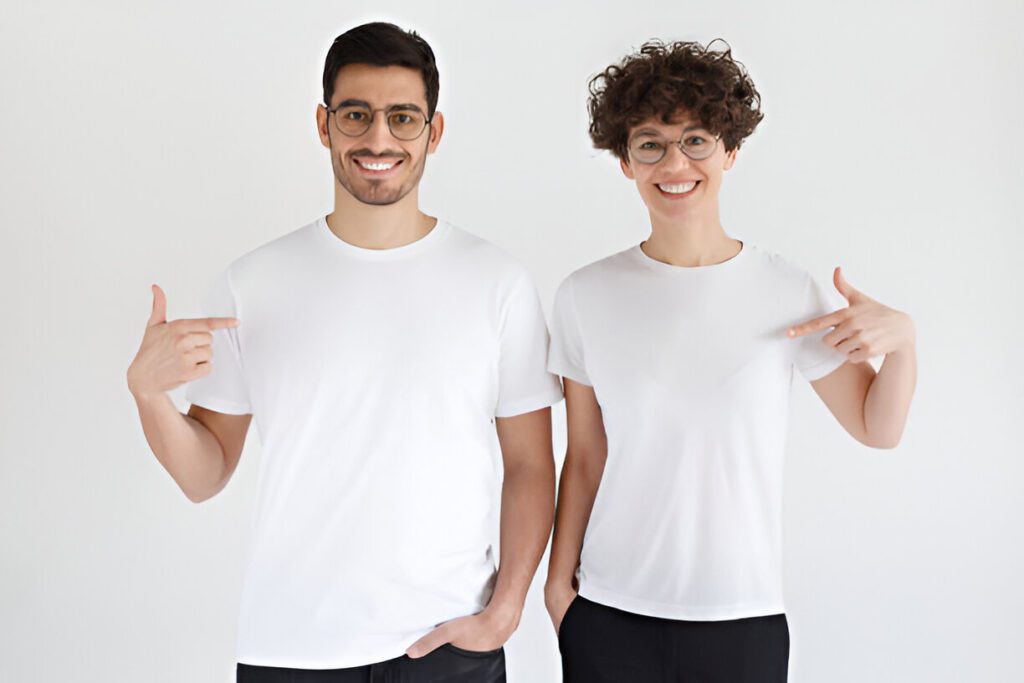Which printing method is best?” is often a question when creating custom T-shirt for your company, event or personal use. Unfortunately, there is no universal answer to that question.
In short, they each have different benefits and disadvantages, durability, and aesthetic effects. Some variables for you to consider are the type of fabric, how you plan on using your shirt, the design, and cost.
TL;DR – Best T-Shirt Printing Method
The best printing method depends on your design, quantity, and budget. Silk screen is the most durable and cost-effective for bulk orders, heat transfer is ideal for small batches or detailed artwork, DTG works well for photo-quality prints, and sublimation is perfect for full-colour sports jerseys. Each method has different strengths in durability, brightness, comfort, and pricing.
In this post, we will break down the most common custom T-shirt printing methods, talk about advantages and disadvantages, and try and help you choose a printing method that meets your needs.


1.Screen Printing
Screen printing is one of the oldest and still one of the most popular T-shirt printing methods. This method makes a stencil or “screen” and use it to apply ink layers to the fabric.
Pros:
• Durable and long-lasting: The inks bond well to the fabric and the designs last over many washes.
• Great colors: The screen-printing method produces great colors, especially for bold, single-color or few-color designs.
• Economical for large orders: Once these screens are developed, printing jobs in bulk reduces the per-piece price.
Cons:
• Not suitable for complex designs: Multi-color, or very detailed artwork takes multiple screens, making it more expensive, and it takes time to set up the whole process.
• Less cost-effective at smaller volumes: The larger up-front costs from the screens are average per piece for larger runs.
2.Direct-to-Garment (DTG) Printing
DTG printing working similarly to an inkjet printer, but printing directly onto fabric instead. It sprays water-based ink to T-shirt material allowing elaborate designs, and accurately, at a high resolution.
Pros:
• Great for detailed designs: DTG is ideal for artwork that contains gradients, photos, or a lot of color.
• No set up costs: Since there are no screens or stencils, DTG printing is inexpensive for low quantities.
• Ink takes on the soft feel of cotton: The ink absorbs into the fabric, rather than leaving a heavy texture on the front of the T-shirt.
Cons:
• Less durable than screen printing: The print may not be as durable as screen printing because it may fade sooner, especially after multiple washes.
• Slower when ordering in bulk: One at a time is slower than, for instance, six at a time using a screen print.
• Best on 90% and 100% cotton: DTG printing is better on certain fabrics.
3.Heat Transfer Printing
Heat transfer is using a special transfer paper, Print your design, then use heat and pressure to transfer the design to the T shirt. This method has been around for years (vinyl heat transfers, digital transfers, etc.).
Pros:
• Great for small runs: Excellent for one-off designs, names or numbers (team jerseys, etc.)
• Special finishes: You have the ability to create metallic, glitter or glow-in-the-dark effects.
• Many uses: Can be used on many fabrics and garments.
Cons:
• Less breathable: Transfer film can feel heavier than DTG or screen printing.
• Durability varies: Designs may crack or peel after repeated washing if not applied properly.
4.Sublimation Printing
Sublimation printing uses heat to transfer dye directly into the fabric fibers. Instead of sitting on top, the ink becomes part of the garment itself.
Pros:
• Extremely durable: Designs won’t fade, crack, or peel.
• Vibrant full-color prints: Perfect for all-over designs.
• Soft finish: The design feels like part of the fabric.
Cons:
• Fabric limitations: Works best only on polyester or poly-blend fabrics, not cotton.
• Not cost-effective for small orders: Usually better for larger runs.
5.Vinyl Printing
Best for: Simple designs, lettering, and custom names/numbers
Vinyl printing involves cutting out designs from sheets of colored vinyl and heat-pressing them onto the T-shirt.
Pros:
• Durable and bold: Vinyl stands up to washes and gives a strong, solid finish.
• Great for personalization: Ideal for adding names, numbers, or logos.
• Special textures available: Can create a glossy, matte, or even flocked (fuzzy) look.
Cons:
• Not suitable for complex designs: Works best for simple text or shapes.
• Limited color options: Each color requires a different vinyl sheet.
So, Which Printing Method Is Best?
The “best” printing method depends on your goals:
• For bulk orders with simple, bold designs → Screen Printing
• For detailed, multi-color artwork in small batches → Direct-to-Garment (DTG)
• For one-off customizations like names/numbers → Heat Transfer or Vinyl
• For all-over, vibrant designs on polyester → Sublimation
Each technique shines in different scenarios. If you’re unsure, think about your design complexity, fabric type, and whether you need a few shirts or a large batch.


Final Thoughts
When selecting the right T-shirt printing method, you have to consider your design needs, budget, and fabric. Whether you want the long-lasting durability of screen printing, the freedom and flexibility of virtually any type of fabric with direct to garment printing, or the vivid coloring of sublimation, there is a method out there to fulfill your needs.
At JS Uniform, we offer specialty printing in numerous printing techniques to make your ideas become reality. Whether you are ordering 100 shirts or 1000, our staff will recommend the best printing method to ensure your T-shirts look fantastic and remain durable.
🎯 Ready to Print Your Perfect T-Shirts?
Get Expert advice on the best printing method for YOUR design. START YOUR QUOTE NOW →
Why choose us?
✅ All printing methods available (Screen, DTG, Sublimation, Vinyl & more)
✅ Bulk discounts for 100+ shirts
✅ Fast turnaround
✅ 100% satisfaction guarantee
Key Takeaways
- Silk screen printing is best for durability and bulk orders.
- Heat transfer is great for small quantities or complex designs.
- DTG is ideal for photo-quality or gradient-heavy images.
- Sublimation works only on polyester but gives vibrant full-colour prints.
- Your choice depends on fabric type, design size, quantity, and budget.
Frequently Asked Questions
1. Which printing lasts the longest on T-shirts?
Silk screen printing is the most durable option. The ink bonds strongly to cotton fabric and withstands repeated washing.
2. Is heat transfer printing good quality?
Yes, especially for detailed artwork or small orders. However, it may crack or peel faster than silk screen if not cared for properly.
3. When should I choose DTG printing?
Choose DTG for photo prints, gradients, or small orders that require full-colour detail without setup fees.
4. What is sublimation printing best used for?
Sublimation is perfect for sports jerseys or polyester materials. It produces bright colours and never cracks or peels.
5. Which printing is most cost-effective for large quantities?
Silk screen printing is the most economical for large batches because the cost per piece decreases significantly.